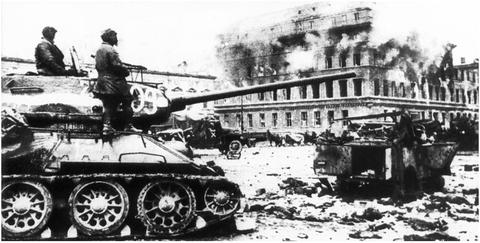The War in Europe's Bloody End

The Third Reich's last week is often described as a lightly contested race between the Allied and Soviet armies to see who could secure the most territory. The reality was anything but so simple. What many Americans don't appreciate is that the vicious fighting characterizing the Nazi-Soviet conflict continued well past the official end of the war. As we approach the 70 year anniversary of the end of the Second World War in Europe's let's remember why many of the combatants at that time hardly felt like celebrating once the Nazi's finally surrendered.
Following Hitler's April 30, 1945 suicide, the Kriegsmarine’s Gross Admiral Karl Doenitz took over as Nazi Germany's new leader, setting up his command near Schleswig-Holstein. Doenitz’s primary purpose was twofold. On one hand, he sought to allow German soldiers and civilians to flee west into Allied hands, rather than surrender to the Russians wreaking vengeance across the eastern lands of the former German Reich. This is widely known and trumpeted in the English speaking world.
On the other hand, what is less commonly known, is that at least initially, Doenitz enthusiastically sought to continue the War. To that end he planned to carry on the fight from Scandinavia, began operations to pull out German soldiers trapped in Courland, sought to make a separate peace with the Allies, dispatched U-boats with orders to fight on from Norway, and even executed his own men for desertion after the War had ended – with three such German soldiers killed on May 10,1945.
As Doenitz sought to continue the National Socialist horror show, Berlin surrendered on May 2nd. The German armies near Berlin fled across the Elbe, or at least attempted to given the Red Army's determined attempts to avoid allowing exactly that. Between April 21st to the 24th the German Ninth Army was encircled in a pocket near Halbe in the Spree forest, southeast of Berlin. The Soviet armies involved included most prominently the 3rd Guards Tank Army, 8th Guards Army, 3rd Army and 28th Army. The Soviet forces allocated to crushing the German pocket ultimately totalled nearly 280,000 men, 280 tanks and self-propelled guns, and 1,500 aircraft.
Heavily weakened in the previous fighting before Berlin the Ninth Army was nowhere near the powerhouse it had been previously in the war. It is estimated that it's ranks comprised only about 80,000 men, with fewer than 100 tanks (most notably featuring just over a dozen King Tigers from the 102nd SS Heavy Panzer Battalion) and no more than 200 armored fighting vehicles. In addition fragments of other German formations had been forced into the pocket.
However Army Group Vistula commander General Gotthard Heinrici, 9th Army commander General Theodor Busse, and 12th Army commander General Walther Wenck planned a breakout. Albeit with Heinrici's role circumscribed by his removal from command for allowing his men to retreat following the mid-April defeat of his defensive positions on the Seelow Heights. The plan was simple; the 9th Army was to attempt to drive west and link up with Wenck's command who would attempt to assist in creating a path for escape. All told there were three major breakout attempts carried out from the end of April through early May.
The first two breakout attempts failed, with only scattered remnants of German forces filtering through Soviet lines. However the third breakout attempt, launched on April 28th succeeded in linking up with the 12th Army and establishing a thin corridor through which anywhere from several thousand to thirty thousand soldiers and civilians fled from Soviet capture. However their safety was relative, because at that point the remnants of the German 9th and 12th Armies then had to fight their way west to the Elbe. Most of them made it into the hands of U.S. soldiers on the river's west bank following crossing operations using a partially intact bridge.
That said, German losses in the combined breakout from the Spree Forest and across the Elbe include up to 120,000 men as prisoners of war (though this is disputed) and estimates today remain all over the map regarding the numbers of those killed. German civilian deaths may have reached 10,000; including those fleeing with the armies or caught up in the intense fighting that ended up raging across the pocket. Estimates of Soviet dead reach as high as 20,000 men. To put that in perspective, this relatively overlooked battle took more lives on either side during a period of just over one week than the U.S. Army lost in the month and a half long Battle of the Bulge that ranks as the largest and bloodiest battle ever fought by the U.S. Army outside of those that occured during the U.S. Civil War. In total the Battle of Berlin cost 125,000 German lives. On the Soviet side Marshal's Ivan Konev, Konstantin Rokossovsky, and Georgy Zhukov's Fronts lost 352,425 men, with over 100,000 killed in the fighting between April 16 and May 8, 1945.
Meanwhile German forces in Italy had surrendered on May 2nd, ending nearly two years of costly warfare on the Italian peninsula. On May 3rd, German soldiers in Denmark, northwest Germany and the Netherlands surrendered to British Field Marshal Bernard Montgomery. But it was not until May 5th when Doenitz sent a liaison to meet with Eisenhower and discuss surrender. Eisenhower demanded immediate unconditional surrender. Accordingly, at 2:41 A.M. and at Eisenhower’s headquarters in Reims the German surrender was signed - to be executed at 11:01 P.M. on May 8, 1945. One final note; fighting on the Eastern Front did not end until one week later. The Red Army's 1st, 2nd, and 4th Ukrainian Fronts endured 49,348 casualties between May 6 and May 11th.



Post new comment